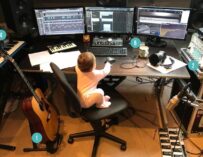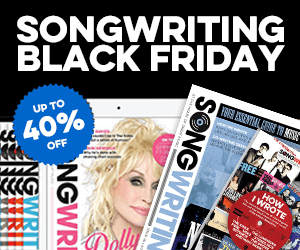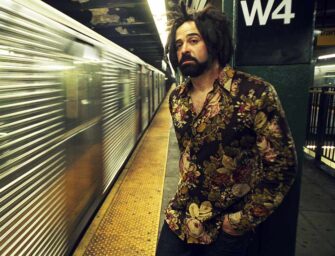
Feeder’s Grant Nicholas: “I’ve generally always written on guitar, especially acoustic guitar, and I can’t see that changing.”
Starting with his Gibson acoustic guitar before moving to his Treehouse studio, the Feeder frontman reveals his essential writing gear
Feeder’s new album Torpedo is the latest triumphant comeback from a rock band that have been defying odds for much of their career. After a short period of lockdown-inspired ennui, the band’s singer and guitarist Grant Nicholas found himself creatively reinvigorated and a new batch of material began to emerge. Working in tandem with bassist Taka Hirose their 11th studio album took shape with Torpedo a fitting name for what may be their heaviest offering to date.
As has been the case with Feeder since their inception in Newport back in the mid-1990s, there’s serious songcraft behind the distortion. Following in the footsteps of classic singles such as Buck Rogers, Just The Way I’m Feeling and Feeling A Moment, early tasters from Torpedo like Magpie and Wall Of Silence proved that Nicholas and Hirose still know how to blend massive riffs with equally sizeable melodies. In fact, having listened to the whole record, Feeder remains a rock band who know how to craft an album in the truest sense.
Here, Nicholas lets us into his songwriting world where animals do roam and vintage pedals provide that classic Feeder sound…
Read more Songwriting Survival Kits
1. ACOUSTIC GUITAR
An acoustic guitar is my go-to when I am writing songs. It’s usually my battle-worn 1967 Gibson J45 which is always near to hand or another that might be laying around. I like the portability of a guitar and it’s how it connects things together with the melodies and lyrics I’m writing. I’ve generally always written on guitar, especially acoustic guitar, and I can’t see that changing.
2. FENDER JAZZMASTER
My Fender Jazzmaster has become a signature guitar for me over the years and it’s one I always use for writing, recording and live work. The songs start off on acoustic and then I go into my studio and plug the Jazzmaster in to see where I can take them sonically. Some of the more riff-based songs lend themselves more to electric guitar and I love that whole process. A guitar can inspire a style so it’s nice to mix it up and feel the song evolve.

Grant Nicholas’ acoustic guitar (left) and Fender Jazzmaster (right): “A guitar can inspire a style so it’s nice to mix it up and feel the song evolve.”
3. CAPO
Capos are really important to me as it brings a different feel to the guitar and also you can find the best key for the song. I’ve always used them and I remember composing the song High back in the 90s from the first Feeder album, Polythene, with one. It’s an essential tool for me and I particularly like the G7th capos as they are easy to put on and you can set the tension just right.
4. VINTAGE PEDALS
I love a lot of vintage effects pedals and gear and have collected quite a bit over the years. I am known for my fuzz sound with Feeder and my favourite pedal which I use when writing and recording is a Coloursound Supa Tonebender. It’s become a staple for me and I’ve used one on most of the heavier Feeder stuff over the years. I use others also but this is my No. 1 fuzzbox of choice and it always inspires new song riffs and parts.

Grant Nicholas of Feeder’s vintage effects pedals and cat: “I find having animals around a studio is good for the soul.”
5. PORTABLE RECORDER
I still have an old school Sony portable cassette recorder which I have used for many years for putting down new song ideas and parts. I love the sound of the tape on the heads and it’s a great way of storing ideas and doing vocal warm-ups. There is a box in my loft of old cassettes full of ideas from years back and a whole load more recent song ideas and parts on my iPhone voice memos. I’ll often get an idea while out walking or travelling so I’ll just sing it into the voice memo so I don’t forget it. I guess my voice is also an important part of writing for me as it’s where I find the melodies.

Grant Nicholas’ iPhone and portable recorder: “I’ll often get an idea while out walking or travelling…”
6. SHARPIE
When writing lyrics, I tend to use a Sharpie on any bit of scrap paper that is lying around. I have tried typing lyrics but don’t get the same feeling and like the hand-written approach. I know it’s more environmentally friendly using a laptop so maybe I need to change my old school ways. I just prefer the handwritten approach.

Grant Nicholas on using a marker pen: “When writing lyrics, I tend to use a Sharpie on any bit of scrap paper that is lying around.”
7. RECORDING STUDIO
I work in my little studio ‘The Treehouse’ with my engineer a lot so it’s an essential part of songwriting for me. It’s a small space but it’s where most of the last three Feeder albums – as well as my solo album, Yorktown Heights – were recorded. Technology has come on leaps and bounds so you really can make a majority, if not all, of an album at home. Live drums need a bigger space but guitars, vocals, percussion and keyboards can all be done there so it’s been a real godsend, especially during lockdown.

Grant Nicholas of Feeder’s recording studio: “You really can make a majority, if not all, of an album at home.”
8. ANIMALS (INCLUDING MY PET CAT, BAMBOO)
I find having animals around a studio is good for the soul. Our family Burmese cat Bamboo is always nearby when I’m playing and writing songs and often comes to hang out with us in The Treehouse studio. She’s so used to music so doesn’t seem too phased by it all, unless it’s heavy guitar time. She often walks across my Wurlitzer or chills out on the studio sofa watching us. She’s a producer from the animal kingdom.

































Related Articles